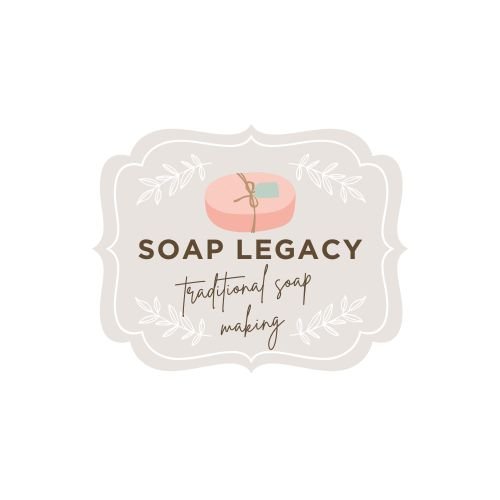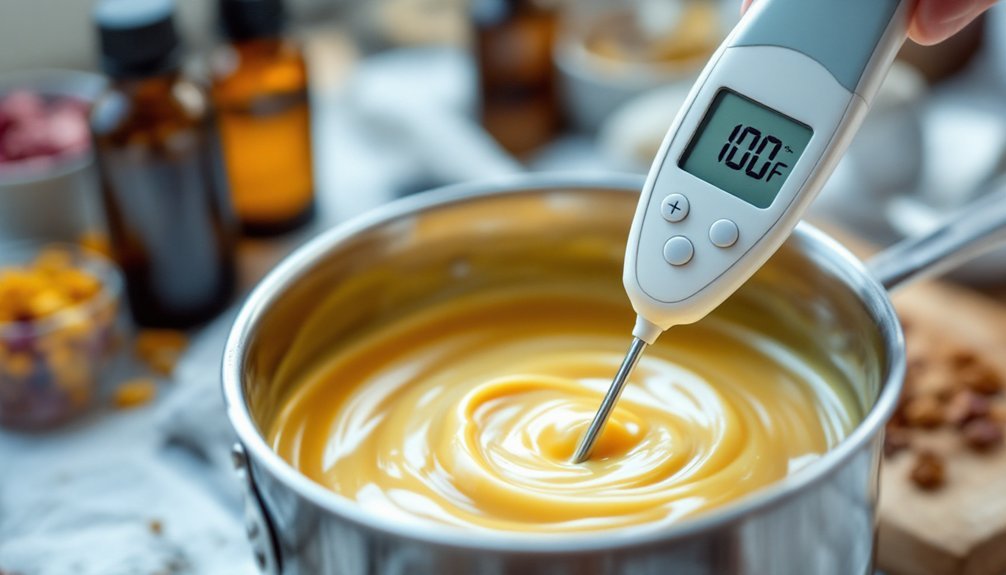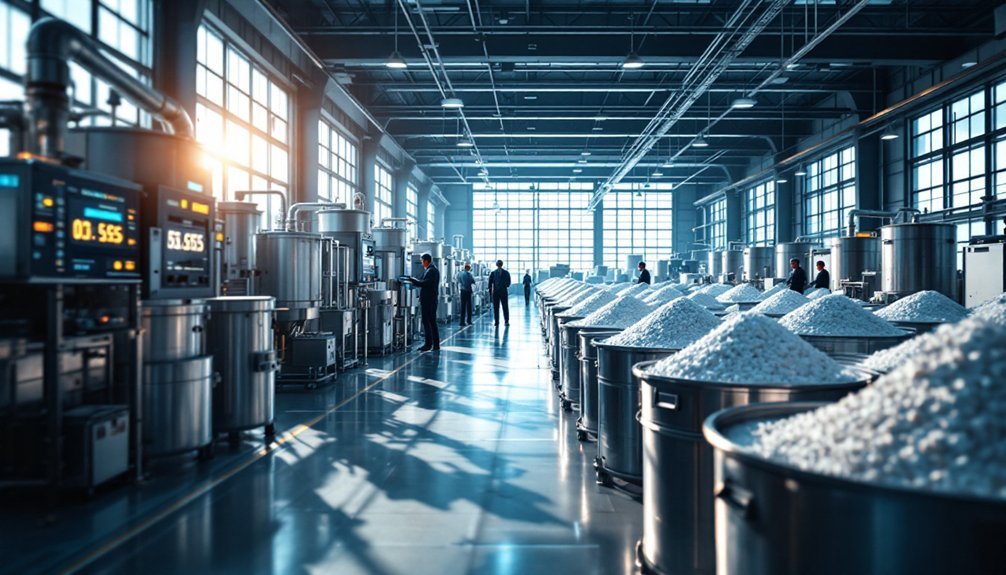Accurate thermometers are essential in cold process soap making because they guarantee your lye solution and oils stay within 10°F of each other. This prevents false trace, ensures proper saponification, and helps you achieve ideal working time with your soap batter. With precise temperature control, you'll avoid separation issues, preserve fragrance integrity, and create consistently high-quality bars. The right thermometer transforms your soaping from unpredictable to reliably successful—discover how temperature precision elevates every aspect of your craft.
Why Accurate Thermometers Matter in Cold Process Soaping

When crafting cold process soap, temperature control isn't just a recommendation—it's vital for success. Accurate thermometers guarantee your lye solution and oils stay within 10 degrees of each other, preventing false trace and guaranteeing proper emulsification during saponification reaction.
Maintaining your lye solution in the ideal temperature range of 70°F to 80°F helps you achieve the perfect trace time and avoids complications when pouring. Without precise measurement, you risk overheating, which accelerates trace and makes your soap batter difficult to work with.
Temperature monitoring also helps achieve the gel phase, improving your soap's texture and quality.
With reliable thermometers, you'll make informed adjustments to keep your soap batter workable, guaranteeing consistent results in every batch you create.
The Science of Temperature in Saponification

Temperature acts as a critical catalyst in saponification, with heat directly accelerating the chemical reaction between your lye solution and oils.
You'll need precise lye temperature control, typically between 70-80°F, to prevent problems like false trace or accelerated reactions that can ruin your soap batch.
When you maintain temperatures within 10 degrees between your lye solution and oils, you're creating ideal conditions for complete saponification and a successful gel phase.
Subheading Discussion Points
Every successful cold process soap begins with a fundamental understanding of temperature's essential role in saponification. When you combine lye and oils within the ideal range of 70°F to 80°F, you're setting yourself up for proper emulsification and manageable trace time.
Accurate temperature control guarantees these ingredients aren't more than 10 degrees apart, preventing complications like false trace that could ruin your batch.
Temperature also determines whether your soap will go through gel phase, which enhances color and texture. Batters starting above 95°F are more likely to gel, giving you control over your soap's final appearance.
Be aware that higher temperatures accelerate the saponification process dramatically—potentially reducing your working time to just 5 minutes. Your thermometer becomes your most valuable tool for predicting and managing these essential chemical reactions.
Heat Accelerates Reactions
Although often overlooked by beginners, the chemistry behind temperature's influence on saponification lies at the heart of successful soap making. When your lye solution and oils maintain temperatures between 95°F and 105°F, you're creating ideal conditions for the chemical reactions that transform raw ingredients into soap.
Heat dramatically accelerates saponification in both cold process and hot process methods. Your careful temperature monitoring can:
- Reduce trace time to just 5 minutes – allowing faster pouring and creative design work
- Prevent dreaded separation issues – keeping your lye solution and oils within 10 degrees ensures proper emulsification
- Activate the critical gel phase – essential for remelting solidified fats and creating that smooth, uniform texture you're aiming for
Temperature control isn't just a suggestion—it's the scientific foundation of successful saponification.
Lye Temperature Control
When handling your lye solution, precision becomes your greatest ally in the saponification journey. The ideal temperature range of 70°F to 80°F guarantees proper mixing with your oils while preventing common pitfalls.
By carefully monitoring the temperature of your lye solution, you'll prevent false trace—that deceptive premature thickening that results in grainy, poorly saponified soap.
The science is clear: maintaining your lye and oil temperatures within 10 degrees of each other creates stable emulsions. A solution that's too cool won't properly melt solid fats, leading to mixing problems.
Conversely, heating and cooling your solution strategically gives you control over reaction speeds. Your thermometer becomes essential for lye temperature control, directly influencing how quickly trace develops and ultimately determining your soap's quality and texture.
How Temperature Affects Trace Development

Temperature plays an essential role in your soap's trace development, directly impacting your ability to create beautiful swirls and designs.
You'll need to maintain your oils and lye solution within 10°F of each other, typically between 70-80°F, to prevent false trace—that deceptive thickening that occurs when cooler temperatures cause butters and hard oils to solidify prematurely.
Keeping your ingredients appropriately warm guarantees the soap batter remains workable long enough for you to execute intricate patterns while still promoting proper saponification.
Mastering False Trace Prevention
Since understanding trace development is essential to successful cold process soaping, you'll need to recognize and prevent false trace situations.
When your thermometer reveals temperature disparities between your lye mixture and oils, you're at risk for premature thickening. Maintain both components between 80°F-90°F to guarantee proper emulsification.
If you notice a grainy, falsely thickened batter, continue mixing until the saponification process generates enough heat to remelt solidified fats. Your thermometer becomes your most trusted ally in this crucial phase of soap making.
- Panic-inducing moment: Watching your carefully formulated recipe suddenly seize into grainy clumps
- Relief and satisfaction: Seeing false trace dissolve into smooth, workable batter after proper temperature adjustment
- Pride of mastery: Producing flawless bars because you monitored temperatures precisely
Temperature's Effect on Swirls
Beyond false trace concerns, your thermometer plays a starring role in creating those mesmerizing swirls that make cold process soaps truly spectacular. The temperature of your batter directly influences trace development—the critical factor determining how long you'll have to create your artistic designs.
| Temperature Range | Effect on Swirls | Recommended For |
|---|---|---|
| 70°F – 80°F | Slow, controlled trace | Intricate swirl patterns |
| 80°F – 95°F | Moderate trace | Balanced designs |
| Above 95°F | Rapid trace, gel phase | Bold colors, simpler swirls |
For ideal swirling results, keep your lye solution and oils within 10 degrees of each other. This guarantees proper emulsification without premature thickening. Working at lower temperatures (70°F-80°F) gives you extended time for complex designs, while higher temperatures accelerate trace—perfect when you need quick setup but challenging for detailed work.
Preventing False Trace and Soap Separation

While many soapers focus on ingredient ratios, accurate temperature control plays an equally crucial role in preventing false trace and soap separation. Your thermometer readings guarantee your lye solution and oils remain within 10 degrees of each other, preventing premature thickening of your soap batter.
When temperatures drop too low, false trace occurs—your mixture looks deceptively thick but will separate later.
For successful soaping results:
- Keep your lye solution between 70°F-80°F to maintain proper emulsification power
- Maintain oils at ideal temperatures (80°F-90°F) to guarantee complete melting of solid fats
- Check temperatures frequently during preparation to catch potential issues before they affect your batch
Don't underestimate the importance of temperature monitoring—it's your best defense against disappointing separations and grainy textures.
Optimizing Temperature for Fragrance and Additive Stability

The delicate chemistry of fragrances and additives demands precise temperature control during cold process soap making. Maintaining your soap mixture between 95°F and 105°F (35°C to 40°C) is vital for preserving the integrity of your carefully selected ingredients.
When temperatures exceed 120°F (49°C), fragrance oils rapidly evaporate or break down, diminishing the scent profile you've worked to create.
Accurate thermometer readings aren't just about successful saponification—they directly impact the quality of your finished product. Essential oils, botanicals, and colorants all respond differently to heat, with many losing their beneficial properties or changing appearance when exposed to excessive temperatures.
Temperature Tools: From Basic to Advanced Monitoring Options
Selecting the right thermometer for your cold process soap making can dramatically improve your results and consistency. Accurate thermometers guarantee your lye solution and oils remain within that vital 10-degree window, preventing frustrating batch failures.
Digital thermometers like the ThermoPro TP03 offer versatility with their wide temperature range (-58°F to 572°F), perfect for measuring both cold and hot components. The infrared thermometer allows you to safely measure the temperature of hot oils and lye without direct contact, while budget-friendly analog options still serve soap makers effectively at around $12.28.
- Peace of mind – knowing your temperatures are precise eliminates guesswork
- Confidence – master the critical mixing phase with reliable readings
- Satisfaction – watch perfect trace develop when temperatures align properly
Mastering the Heat Transfer Method With Precision
Why struggle with separate heating and cooling processes when the heat transfer method offers an elegant solution for cold process soaping? This technique leverages your hot lye solution's natural heat to melt solid oils, but success hinges on temperature control. Your accurate thermometer becomes indispensable here.
| Temperature Factor | Precision Impact |
|---|---|
| Lye Solution | Maintain 80-90°F for ideal melting |
| Oil Temperature | Keep within 10° of lye temperature |
| Soft/Hard Oil Mix | Combine before adding lye for even melting |
| Saponification Efficiency | Proper temperatures promote successful gel phase |
Temperature Control for Achieving Perfect Gel Phase
Now that you've mastered the heat transfer method, let's focus on temperature's role in achieving that coveted gel phase. Your thermometer isn't just a tool—it's your gateway to soap perfection.
Maintaining temperatures between 95-105°F guarantees your soap mixture enters gel phase naturally, where saponification generates enough heat to remelt and integrate ingredients completely.
For successful gel phase achievement:
- Keep lye solution and oils within 10 degrees of each other to prevent false trace that could sabotage your beautiful creation.
- Monitor consistently at 95°F minimum to initiate the transformative process that delivers vibrant colors and smooth texture.
- Trust your accurate temperature readings during critical mixing stages—don't let guesswork ruin hours of preparation.
Precise temperature control isn't optional; it's the difference between ordinary soap and extraordinary artisanal creations.
Frequently Asked Questions
How Does Temperature Affect Saponification?
Temperature directly impacts your saponification process. If it's too high, you'll see accelerated trace and possible seizing. When it's too low, you'll experience false trace or separation in your soap mixture.
Which Thermometer Is Best for Soap Making?
For soap making, digital thermometers like the ThermoPro TP03 offer you precise readings quickly. If you're handling hot lye, consider an infrared thermometer for safer non-contact measurements. Both guarantee accurate temperatures for successful saponification.
How Does Temperature Affect Cold Process Soap?
Temperature affects your cold process soap dramatically. It impacts trace time, consistency, emulsification, and additive performance. Too hot and you'll get fast trace; too cold and you'll risk false trace and separation issues.
What Is the Best Temperature for Curing Soap?
For curing soap, you'll want to maintain a temperature between 70-80°F (21-27°C) in a well-ventilated area. This range guarantees proper saponification while preventing issues like false trace and excessive moisture retention.
In Summary
You'll find that accurate temperature monitoring transforms your soaping from unpredictable to reliable. By investing in quality thermometers and understanding temperature's role in the saponification process, you're setting yourself up for consistent success. Whether you're working with delicate additives or mastering complex techniques, precision matters. Your attention to temperature control won't just improve your soap—it'll revolutionize your entire crafting experience.





Leave a Reply